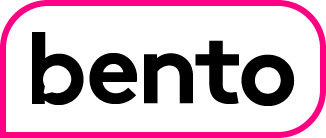Designing for Trust
A conversation with Nathan Carnes, Bento Product Manager
Bento works with community and healthcare organizations to help them serve their most vulnerable populations. What have you learned about building trust amongst these communities?
Nathan: It all starts with access to food. Each patient population is unique and every patient is different, but one thing is consistent: no one is equipped to think about their long-term health while they’re hungry. Until we can stabilize a persons’ nutritional needs, it’s essentially impossible to engage them in the right health care programs to manage chronic conditions.
So the first step is always: get people meals. Providing meals to participants in a way that honors their dignity as human beings builds trust (and faster than just about anything else).
“Once trust is established and “what am I going to eat today?” is addressed, people are more likely to engage in disease prevention programs and other interventions that align with their health care providers’ goals.”
What have been some of the things you’ve learned, as it relates to the product?
Nathan: One of the most important lessons I keep re-learning is how crucial choice and variety are to the populations we serve.
“The foods we eat are deeply personal, but traditional food insecurity programs often don’t offer any choice in what they provide people to eat – you’re just supposed to be grateful for whatever calories you get.”
It’s critical that Bento provides not only nutritionally and culturally appropriate foods, but also enough variety to keep it interesting. No one wants to eat grilled chicken with steamed broccoli and brown rice every day, regardless of how healthy it is; food insecure populations are no different than anyone else in that.
Another thing we’ve learned as a company in the past year is obvious in hindsight: no one wants to eat out for every meal. Bento’s restaurant meal offerings are an amazing tool to meet folks’ immediate needs and provide them flexibility as they go throughout their day, but ideally those meals would be supplementing groceries at home, not replacing them. A hybrid approach that incorporates both healthy groceries and restaurant meals makes the most sense for most people.
What have been adjustments you’ve made to improve access to the people Bento serves?
Nathan: First and foremost, if a service isn’t available in your language, it’s going to be difficult or impossible for you to access. It doesn’t matter how easy Bento is to use, if you speak Spanish and Bento is only in English, it’s not going to work well for you.
We’ve added full support for Spanish and will continue to expand into other languages to provide everyone we’re serving with equitable access and the dignity of interacting with our platform in their preferred language.
One of the major themes running through all of our product thinking at Bento is that of agency.
“How can we provide the people we serve with as much control over when, how, and what they eat as possible without making Bento complicated to use?”
For example, when we first started experimenting with grocery pickup, participants were assigned a time to pick up the groceries. Not surprisingly, this often didn’t work around people’s busy lives. Now that same participant can select a convenient time that works for them. It’s the same box of groceries, but we’ve been able to give participants more control and choice in how they get them.
That theme of agency also shows up in the product in small ways, like adding the STATUS keyword so participants can see where they’re at in their program. Anything we can do to provide more control and transparency to participants while still providing them with a system that “just works” is a priority for us as a Product team.
How does frictionless innovation translate in your work?
Nathan: Bento is really built from the ground up to be as frictionless as possible. You don’t need to download and install an app. You don’t even need a smartphone, or even a data plan; all you need is SMS, which over 97% of Americans have access to. Rather than building a shiny smartphone app for our own vanity, Bento uses simple, robust technologies that nearly everyone is already comfortable with.
“Our goal is to make access to nutritious food as easy as possible. Being able to order a meal near you with a few text messages helps us maintain the lowest barrier to entry for participants receiving Bento.”
Despite all of the complexity happening behind the scenes, the user experience should always feel simple, reliable, and dignified.
What in your mind are the most important things about our product and how do you feel it compares to other products you’ve worked on?
Nathan: The most important and unique thing about Bento as a product is how important it is in our users’ lives.
With most technology products, your product is completely removed from tangible outcomes in a person’s life; it’s abstract. Perhaps your product generates data, and people can use that data to make better decisions, and maybe at the end of some long process that translates to an impact in the world, but it’s indirect and diffuse. On top of that, the majority of technology products are created with an idea of how to make money, not an idea of how to improve people’s lives.
Bento doesn’t work like that.
“People use Bento to access meals every day, often during a vulnerable period of their lives. If Bento as a product works well, then they get a nutritious meal that day, and can focus the energy that would have otherwise gone to finding that meal to other needs. And if not – if we screw up – someone may be going to bed hungry. It’s a humbling responsibility, and one that we could not take more seriously.”
